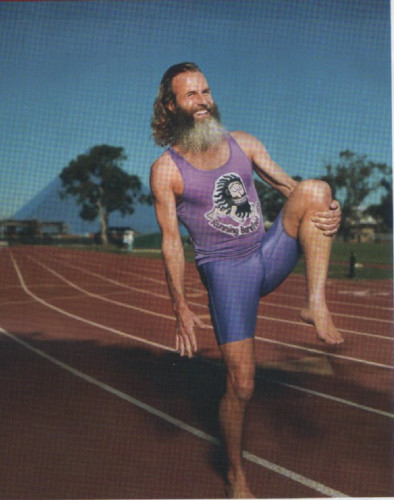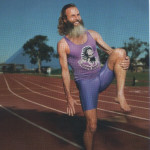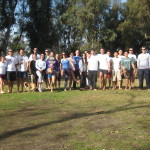Runner's World Magazine 2005 May The Human Race by Jon Regardie
The question you’re already asking, the answer is yes, Ken Bob Saxton has hurt himself while running barefoot. It happened twice. In the first and more serious instance during the Napa Valley Trail Marathon in 1998, he finished and discovered a quarter-inch gash on the side of his foot.
“There was a line on the sole of my foot,” says the affable, scraggly bearded Saxton while sitting on his sofa in Huntington Beach, California, his dog Herman at his (bare) feet. “I probably stepped on a sharp rock in one of the streams and it must have slid along the bottom of the foot, not cutting there, because that skin is tougher, but cutting the side of my foot. The water washed it and I kept going, and I didn’t know about it until I finished”.
He adds, “but two days later I was able to run 20 miles, so it wasn’t that bad.”
Another time, Saxton stepped on a shard of glass in a 10-K. He stopped, plucked it out, and soon caught up to the person he had been running with.
Saxton, 49, last wore running shoes in 1987. Ten years later he started going barefoot to work (he’s a computer technician at a college_. He has completed about 35 marathons (and ultras) without shoes. He routinely complies with postrace requests o check out the soles of his feet–they are smooth and uncalloused. The founder of runningbarefoot.org, Saxton ran a marathon a month in 2004 to promote his au natural agenda. To keep travel costs down, he ran mostly in California (Los Angeles, Rock ‘N’ Roll San Diego, Big Sur, among others), finishing in 3:26, his fastest time [editor: of that year]. He also made it to Boston, which was his slowest race–5:25 on a hot day. “Boston was good, other than the fact that I ran a really bad marathon,” he says. He’ll return this year to try to improve his time.
Along the way, Saxton has become a sort of spokesman for the shoeless. “You don’t need a $100 pair of shoes,” he says. “It’s not running that’s damaging the body, it’s running badly. And shoes just encourage that.”
Saxton believes that most runners land on their heel, and that the shock of that jarring impact reverberates through the body, damaging the knees and back. The cushioning of shoes, he argues, makes people unaware of the impact, so even more harm is inadvertently done. Thus Saxton shed his shoes and altered his style: Instead of hitting his heels, he bends his knees, and lands on the balls of his feet [editors: ball-first, then heel], with his feet falling under his body. Saxton claims this clumsy-looking gait is gentler on the his body [editor: it doesn’t look as clumsy as it feels, and it only feels clumsy because people have become used to slamming their heels into the asphalt].
Saxton says neither cold nor heat has ever posed a problem and that years of barefoot running have honed his senses to debris on the road. “I step on glass, pebbles, things like that all the time,” he says. “Your foot will react to it and shift away from the parts that are painful, because that’s what the nerves are for. You train the nerves by using them.”
Aficionados point to barefoot heroes like 1984 Olympian Zola Budd and Ethiopian Abebe Bikala, who won the 1960 Olympic Marathon sans shoes. Critics warn against barefoot running on pavement for long distances, believing that impact and debris simply pose too many dangers. Bob Girandola, an associate professor of kinesiolgy at USC and the author of the 1988 book, Running for Lifetime Fitness, agrees that the human foot evolved for barefoot running, which itself strengthens muscles. Yet, he notes, everything changes after a lifetime of wearing shoes. “When your foot hits the ground, you hit with two to three times body weight.” he says. “A lot of the materials in good running shoes cushion some of this shock, and bare feet won’t do that.”
[editor: But bare feet are sensitive to impact which encourages runners to run with less impact with each and every step]
Of course, doubt is nothing new to Saxton. It doesn’t stop him from running barefoot on the sidewalk near his home, as well as at the beach, sometimes with his wife, Cathy (in shoes), and often with Herman the dog. People have gotten used to him around town, and some even recognize him in races. “I get a lot of engouragement,” says Saxton. “It’s like a fan club wherever you go. People always yell out, ‘Go barefoot guy!'”
- Runner’s World 2005 May Human Race p27-28
- 2005 May Human Race, photo by Emily Shur



